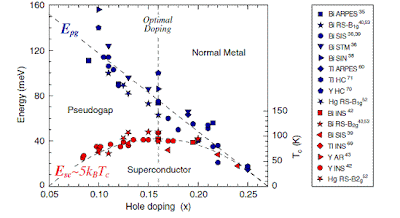I just finished reading a very nice review article, "Two gaps make a high-temperature superconductor?" From a broad range of experimental data for several classes of cuprates they produce this figure:
 The important point is that there are two energy gaps, both with a d-wave momentum dependence. The upper line describes the pseudogap and the lower curve the superconducting gap. This is consistent with the phase diagram in which the pseudogap vanishes at the same doping as the superconductivity.
The important point is that there are two energy gaps, both with a d-wave momentum dependence. The upper line describes the pseudogap and the lower curve the superconducting gap. This is consistent with the phase diagram in which the pseudogap vanishes at the same doping as the superconductivity.The article is a short review of experimental data and does not consider how this compares to different theories of the pseudogap in the cuprates.
I may be missing something but it seems to me that this physics was actually predicted twenty years ago in a paper by Zhang, Gros, Rice, and Shiba. The emergence of these two d-wave gaps is described by a resonating valence bond wave function. Below is Figure 6 of the paper:






No comments:
Post a Comment